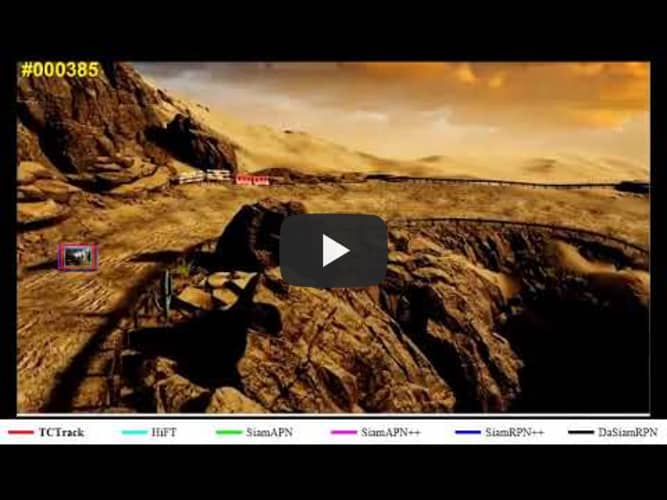TCTrack: Temporal Contexts for Aerial Tracking (CVPR2022)
Ziang Cao and Ziyuan Huang and Liang Pan and Shiwei Zhang and Ziwei Liu and Changhong Fu
In CVPR, 2022.
[paper]
Abstract
Temporal contexts among consecutive frames are far from being fully utilized in existing visual trackers. In this work, we present TCTrack, a comprehensive framework to fully exploit temporal contexts for aerial tracking. The temporal contexts are incorporated at two levels: the extraction of features and the refinement of similarity maps. Specifically, for feature extraction, an online temporally adaptive convolution is proposed to enhance the spatial features using temporal information, which is achieved by dynamically calibrating the convolution weights according to the previous frames. For similarity map refinement, we propose an adaptive temporal transformer, which first effectively encodes temporal knowledge in a memory-efficient way, before the temporal knowledge is decoded for accurate adjustment of the similarity map. TCTrack is effective and efficient: evaluation on four aerial tracking benchmarks shows its impressive performance; real-world UAV tests show its high speed of over 27 FPS on NVIDIA Jetson AGX Xavier.
The implementation of our online temporally adaptive convolution is based on TadaConv (ICLR2022).
1. Environment setup
This code has been tested on Ubuntu 18.04, Python 3.8.3, Pytorch 0.7.0/1.6.0, CUDA 10.2. Please install related libraries before running this code:
pip install -r requirements.txt
2. Test
Download pretrained model by Baidu (code: 2u1l) or Googledrive and put it into tools/snapshot directory.
Download testing datasets and put them into test_dataset directory.
python ./tools/test.py
--dataset UAV123_10fps
--tracker_name TCTrack
--snapshot snapshot/general_model.pth # pre-train model path
The testing result will be saved in the results/dataset_name/tracker_name directory.
Note: The results of TCTrack can be downloaded (code:kh3e).
3. Train
Prepare training datasets
Download the datasets:
Note: train_dataset/dataset_name/readme.md has listed detailed operations about how to generate training datasets.
Train a model
To train the TCTrack model, run train.py with the desired configs:
cd tools
python train.py
4. Evaluation
If you want to evaluate the results of our tracker, please put those results into results directory.
python eval.py \
--tracker_path ./results \ # result path
--dataset UAV10fps \ # dataset_name
--tracker_prefix 'general_model' # tracker_name
Note: The code is implemented based on pysot-toolkit. We would like to express our sincere thanks to the contributors.
Demo video
References
@article{cao2022tctrack,
title={{TCTrack: Temporal Contexts for Aerial Tracking}},
author={Cao, Ziang and Huang, Ziyuan and Pan, Liang and Zhang, Shiwei and Liu, Ziwei and Fu, Changhong},
journal={arXiv preprint arXiv:2203.01885},
year={2022}
}
Acknowledgement
The code is implemented based on pysot. We would like to express our sincere thanks to the contributors.

